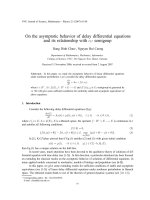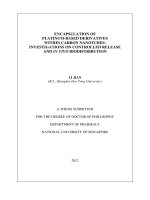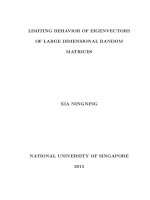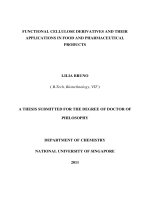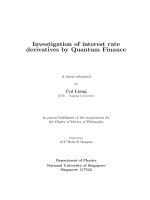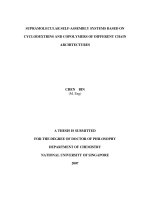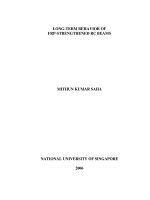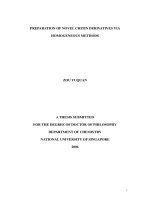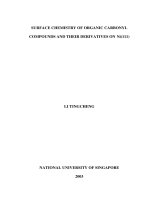Benchmarking supramolecular adhesive behavior of nanocelluloses, cellulose derivatives and proteins
Bạn đang xem bản rút gọn của tài liệu. Xem và tải ngay bản đầy đủ của tài liệu tại đây (2.07 MB, 9 trang )
Carbohydrate Polymers 292 (2022) 119681
Contents lists available at ScienceDirect
Carbohydrate Polymers
journal homepage: www.elsevier.com/locate/carbpol
Benchmarking supramolecular adhesive behavior of nanocelluloses,
cellulose derivatives and proteins
ăm b, c, Junling Guo d, Joseph J. Richardson e,
Otso I.V. Luotonen a, Luiz G. Greca a, Gustav Nystro
a, f, *
a, g, h, *
Orlando J. Rojas
, Blaise L. Tardy
a
Department of Bioproducts and Biosystems, School of Chemical Engineering, Aalto University, P. O. Box 16300, FI-00076 Aalto, Finland
Laboratory for Cellulose & Wood Materials, Empa – Swiss Federal Laboratories for Materials Science and Technology, Überlandstrasse 129, 8600 Dübendorf,
Switzerland
c
Department of Health Science and Technology, ETH Zürich, 8092 Zürich, Switzerland
d
BMI Center for Biomass Materials and Nanointerfaces, College of Biomass Science and Engineering, Sichuan University, Chengdu 610065, China
e
Department of Materials Engineering, School of Engineering, University of Tokyo, Tokyo 113-8656, Japan
f
Bioproducts Institute, Department of Chemical and Biological Engineering, Department of Chemistry and Department of Wood Science, University of British Columbia,
2360 East Mall, Vancouver, BC V6T 1Z4, Canada
g
Khalifa University, Department of Chemical Engineering, Abu Dhabi, United Arab Emirates
h
Research and Innovation Center on CO2 and Hydrogen, Khalifa University, Abu Dhabi, United Arab Emirates
b
A R T I C L E I N F O
A B S T R A C T
Keywords:
Natural polymers
Biopolymers
Cellulose
Carbohydrate
Nanocellulose
Nanocrystal
Cellulose derivatives
One of the key steps towards a broader implementation of renewable materials is the development of biode
gradable adhesives that can be attained at scale and utilized safely. Recently, cellulose nanocrystals (CNCs) were
demonstrated to have remarkable adhesive properties. Herein, we study three classes of naturally synthesized
biopolymers as adhesives, namely nanocelluloses (CNFs), cellulose derivatives, and proteins by themselves and
when used as additives with CNCs. Among the samples evaluated, the adhesion strength was the highest for
bovine serum albumin and hydroxypropyl cellulose (beyond 10 MPa). These were followed by carboxymeth
ylcellulose and CNCs (ca. 5 MPa) and mechanically fibrillated CNFs (ca. 2 MPa), and finally by tempo-oxidized
CNFs (0.2 MPa) and lysozyme (1.5 MPa). Remarkably, we find that the anisotropy of adhesion (in plane vs out of
plane) falls within a narrow range across the bio-based adhesives studied. Collectively, this study benchmarks
bio-based non-covalent adhesives aiming towards their improvement and implementation.
1. Introduction
interfacial non-covalent interactions of bio-colloids and natural bio
polymers are what dictate their ability to form high strength bonds with
themselves (cohesive) and at other interfaces (adhesive) (Daicho,
Kobayashi, Fujisawa, & Saito, 2021; Greca et al., 2021; Mittal et al.,
2018; Tardy et al., 2020). High overall strength can be achieved by an
array of noncovalent bonds which are individually relatively weak
(Wang et al., 2019), and different bio-colloids and biopolymers can be
consolidated through confined evaporative processes into structures of
multi-scale order. Across different applications, such non-covalent, su
pramolecular, interactions determine the performance of natural fibre
based composites (Mattos et al., 2020; Siqueira et al., 2017; Yang et al.,
2021), natural polymers assemblies (Beaumont et al., 2021; Chen et al.,
2020; Korhonen, Sawada, & Budtova, 2019), and the formation of nat
ural adhesives and binders (Greca et al., 2021; Tardy et al., 2020).
As the global economy transitions towards sustainable materials,
natural biopolymers resulting from natural biosynthetic processes are
gaining increased attention due to their renewable nature and inherent
biodegradability (Tardy et al., 2021). The need to replace synthetic
materials is imminent, as hazardous plastics are currently massproduced despite their short service-life and uncontrolled end-of-life,
which collectively lead to the introduction of contaminants into eco
systems and food chains (Cole, Lindeque, Halsband, & Galloway, 2011;
Geyer, Jambeck, & Law, 2017). The dramatic increase in plastic use for
short service-life items in packaging and logistics in the post-COVID era
(valued at over $59 billion USD in 2020) highlights the urgent need to
better understand and utilize natural biopolymers. In particular, the
* Corresponding authors at: Department of Bioproducts and Biosystems, School of Chemical Engineering, Aalto University, P. O. Box 16300, FI-00076 Aalto,
Finland.
E-mail addresses: (O.J. Rojas), (B.L. Tardy).
/>Received 14 March 2022; Received in revised form 14 May 2022; Accepted 28 May 2022
Available online 1 June 2022
0144-8617/© 2022 The Authors. Published by Elsevier Ltd. This is an open access article under the CC BY license ( />
O.I.V. Luotonen et al.
Carbohydrate Polymers 292 (2022) 119681
Recently, the self-assembly of bio-colloids such as nanocellulose has
been explored to form adhesives between glass, and other hydrophilic
surfaces, upon directionally controlled drying of the dispersion, i.e.
using confined evaporation-induced self-assembly (C-EISA, Beisl,
Adamcyk, Friedl, & Ejima, 2020; Tardy et al., 2020). Although the ad
hesives exploit non-covalent interactions, the shear strength can reach
up to 9 MPa. Natural biopolymers, such as proteins, carbohydrate
polymers, and their biocolloidal supramolecular assemblies are largely
biosynthesized building blocks that are also industrially produced in
large quantities (Ajdary, Tardy, Mattos, Bai, & Rojas, 2021; Li et al.,
2021; Tardy et al., 2021). Most of these biomacromolecular constructs
are water soluble/dispersible, which allows for aqueous processing into
different materials based on the interfacial interactions and rheology of
the bio-colloidal building block suspensions (Genỗer, Schỹtz, & Thieleư
mans, 2017; Greca et al., 2021; Klockars et al., 2019; Tardy et al., 2017,
2020). While their assembly and associated materials properties have
been intensely studied over the past decade, there are no benchmarks for
the performance of their interfacial interactions. This knowledge gap in
interfacial interactions is untimely due to the rising demand for biobased adhesives to provide green solutions for bonding systems in
various industries.
Herein, we aimed to address this gap by evaluating the adhesive
properties of a range of distinctly different classes of bio-colloids and
biomacromolecules (Fig. 1a). We also explore their impact as additives
in combination with CNC, with the goal of highlighting potential syn
ergies. This is expected to provide insights into the overarching design
principles underpinning bio-colloidal adhesives, including e.g. consid
erations on the effect of disordered aggregation induced by the presence
of the additive prior to assembly and during joint formation. We spe
cifically evaluated on their own or as composites with CNCs: (1) higher
aspect-ratio nanocellulose, such as mechanically fibrillated cellulose
nanofibres (CNFs) with four degrees of fibrillation, which were previ
ously shown to also impart higher toughness when added into CNC
materials (Mattos et al., 2020; Natarajan et al., 2018), (2) two well
established model proteins, namely bovine serum albumin (BSA, iso
electric point (IP) 4.7 (Yasun et al., 2015), MW 66 kDa) and lysozyme (IP
11.7 (Felsovalyi, Mangiagalli, Bureau, Kumar, & Banta, 2011), MW 14.4
kDa), and (3) cellulose derivatives, namely carboxymethylcellulose
(CMC (Cheng, Wyckoff, Dowd, & He, 2019; Filpponen et al., 2012;
ărling,
Mittal & Pizzi, 2003)) and hydroxypropyl cellulose (HPC (Dore, Do
Garcia-Pomar, Campoy-Quiles, & Mihi, 2020; Espinha et al., 2018;
Walters, Boott, Nguyen, Hamad, & MacLachlan, 2020; Yi et al., 2019)).
Proteins see much attention as potential sources of novel adhesives, and
more specifically BSA can produce strong adhesion on its own (Roberts
et al., 2020), while lysozyme has been studied together with cellulose
and chitin nanocrystals to produce films and adhesives (De France,
ăm, 2020; Greca et al., 2021). The aim
Kummer, Ren, Campioni, & Nystro
of using cellulose derivative was to provide a softer matrix potentially
improved the toughness of CNC-only joints. These natural biopolymers
are typically available at low costs at commercial scales and cover a
distinct gelation concentration range, corresponding to lower than 1%
for TOCNF to above 50% for BSA, making them suitable benchmarks for
future studies.
The joints were evaluated for their long-range order, contact area,
lap-shear strength, and out-of-plane adhesive strength. Meta-analysis of
the adhesive strength was performed by normalizing the load to the
actual load-bearing or contact areas, which enabled us to provide clear
guidelines on what are the key features to look for in natural bio
polymers for the design of high strength adhesive formulations.
Importantly, the anisotropy of adhesion of evaluated systems, i.e. their
out-of-plane strength vs shear-strength (Fig. 1b) was analysed to illus
trate the principles governing supramolecular interaction of natural
biopolymers, which may bear similarities regardless of their confor
mation, size, or other physicochemical properties (Fig. 1b).
2. Experimental
2.1. Materials
CNCs (ca. 10%, w/v) were acquired through the Process Develop
ment Center, University of Maine, USA (FPL, Madison, WI). These have
been characterized in a previous study: length and width 134 ± 52 nm
and 7 ± 2 nm resp., sulfate half-ester content 335 mmol/kg, zeta po
tential ca. -47 mV (Reid, Villalobos, & Cranston, 2017). Mechanically
Fig. 1. (a) Adhesion of glass surfaces using various bio-colloids and bio-macromolecules with C-EISA (confined evaporation-induced self-assembly). (b) Their
adhesion strength was measured under in-plane and out-of-plane loads highlighting distinct mechanisms of failure, which can be ascribed to the dynamic interfacial
interactions of the biomacromolecules.
2
O.I.V. Luotonen et al.
Carbohydrate Polymers 292 (2022) 119681
fibrillated CNFs were prepared by mechanical disintegration from
never-dried, fully bleached and fines-free sulphite birch pulp (Kappa
number of 1, DP of 4700) suspended in distilled water at 1.8% (w/v).
The suspension was disintegrated using a high-pressure fluidizer
(Microfluidics M110P), the number of fluidizer passes is indicated with
mechanically fibrillated CNFs (e.g. 9pCNF: 9 passes). Mechanically
fibrillated CNFs are characterized by partial fibrillation, requiring care
when interpreting simple dimensional characterizations (Mattos, Tardy,
& Rojas, 2019). However, average dimensions of CNFs produced using
the same materials and devices as in this work (with 6 fluidizer passes)
have been determined: 1.46 ± 0.8 μm length and 35 ± 12 nm diameter
(Mattos et al., 2019). They typically have a slightly negative zeta po
tential from residual heteropolysaccharides bound to the surface, mainly
xylans; a numerical value of − 2 mV has been reported, for example (Lou
et al., 2014; Toivonen et al., 2015). TEMPO-oxidized CNF (TOCNF) was
prepared as described by Orelma et al. (2016). TOCNFs produced the
same way as in this work have been characterized in earlier work, as
having lengths of several microns and diameter equal to that of
elementary fibrils of wood, i.e. ~4 nm (Beaumont et al., 2021). The
charge content was 1.36 meq./g (Reyes et al., 2020). BSA and hen egg
white lysozyme were purchased from Sigma-Aldrich. Sodium salt of
CMC (MW 250 kDa, DS 1.2), and HPC (MW 100 kDa, DS 2.2 (Dubolazov,
Nurkeeva, Mun, & Khutoryanskiy, 2006)) were purchased from SigmaAldrich. The following commercial adhesives were briefly tested for
comparisons: Loctite Power Epoxy and Casco Express Gel, a cyanoac
rylate adhesive.
joints. Although this strategy was also used to avoid slippage of the
sample, it was not possible to completely eliminate such events given the
high loads used and the submillimeter strain at break of the samples.
Therefore, no toughness values are calculated in this work. The strain
rate was set to 1.5 mm min− 1 and the distance between clamps was kept
at ca. 60 mm. The maximal load before failure was used to measure inplane adhesion. It should be noted that among CNF-containing speci
mens, results would vary between tested sets, in a grouped manner. This
may be due to particular susceptibility to changes in environment, such
as humidity. Furthermore, consolidation required a considerably longer
time (>30 h and typically 70 h) to obtain measurable strengths.
Out-of-plane adhesion was measured with the MTS 400M tester in
compression mode (Fig. S2). The joint was clamped horizontally onto a
thick aluminium plate with a bulldog clip and a thin piece of aluminium.
A small steel plate was pushed down onto one glass slide near the joints
border, to provide the out-of-plane load. This setup provides informa
tion on out-of-plane adhesion and toughness, with its geometry being
reminiscent of the Boeing wedge test, which develops a crack in the
material starting from one end. For HPC-only joints, the out-of-plane
tests (OoPF) resulted in frequent substrate failure.
Surface coverage by the dried material within a joint was estimated
using ImageJ analysis of joint photographs. The surface coverage values
were employed for a more representative estimation of shear stress
within the material, by assuming the surface coverage to be equivalent
to the contact area between the adhesive material and the substrate. In
other words, shear stress values were calculated in two different ways:
(1) using the whole 2.5 cm2 joint area (“lap shear stress”), and (2) using
the estimated average surface coverage area for a given formulation
(“ultimate shear stress”). The former corresponds with the common
definition used in literature, while the latter gives more accurate insight
into the adhesive material's properties.
We note that the dry matter content and areal densities within the
overlap areas were maximized based on either substrate failure
(maximum amount of bio-adhesive resulting in joint failure rather than
substrate failure), gelation concentration (maximum concentration
where the viscosity of the dispersion was sufficiently low to induce good
wetting and therefore good adhesion), or chosen to facilitate comparison
of formulations. For instance, BSA with CNCs at the same areal density
as other samples (0.44 mg/cm2) led to in-plane adhesion that caused
substrate failure in many of the specimens (non-substrate failure values
averaged at 580 N). Due to this, BSA formulations were studied at a
lower areal density of 0.2 mg/cm2.
2.1.1. Preparation of lap joints
Lap joints were chosen as the specimen to evaluate joint properties
(Fig. 1). These were prepared by placing 20 μL of adhesive formulation
onto a glass microscope slide (VWR International). The formulations
were made by dissolving compounds into a volume of deionized water
leading to the DMC aimed for. For combination formulations, the
composition is indicated as the included components followed by the
relative contents by weight for multiple components, e.g. CNF-CNC1:10.
Dry matter content (DMC, also called wt%) is also indicated when
relevant, as a simple indicator of the formulation concentration, and
complemented by the average areal density (mg/cm2) of the produced
joints. Another slide was then carefully placed on top of the liquid, to
create a thin film between the two slides. The top slide was carefully
levelled using a third glass slide to maintain planar contact. The overlap
to be joined was ca. 25 mm wide and 10 mm long. The lap joints were
then left to dry at room temperature, ca. 23% RH, for a minimum of 18 h
before imaging and a minimum of 30 h before mechanical testing.
2.1.4. Gelation concentration estimation
The gelation behavior of the studied biomacromolecules was esti
mated through the vial inversion tests. A given amount of each com
pound was dissolved into 10 mL with deionized water in a ca. 2 cm wide
glass vial, to concentrations of up to 50% (w/v). The gelation behavior
was characterized by inverting the vial and observing whether the so
lution could flow downwards with only the force of gravity.
Additional details on experimental protocols described herein and
deeper discussions on adhesive joints designs are accessible in the
reference: Luotonen (2021).
2.1.2. Imaging of joints
Joints were mostly photographed with a digital camera (10 MP
resolution) in a dark room, illuminated with a fibre optic lamp (Fig. S1).
The lysozyme and cellulose derivative-only joints were imaged on an
Olympus SZX10 microscope without magnification.
Long range order was visualized using ordinary and polarized optical
transmission microscopy (Olympus BX53M microscope), with the aid of
a retardation plate (530 nm) to visualize relative orientation of the
birefringent domains and increase the discernibility of details. The joints
were imaged after drying, without further preparation steps.
Scanning electron microscopy (SEM) was used to image select
representative samples, using a Zeiss Sigma VP device with a Schottky
field emission source. The samples consisted of joints broken either
under an in-plane or out-of-plane load (specified in the results), coated
with a 4 nm thick layer of platinum/palladium alloy.
3. Results and discussion
The various natural biopolymers studied herein showed very
different behaviours under C-EISA, both when combined with CNCs and
on their own (Fig. 2). Bio-macromolecules and bio-colloids can interact
with themselves and other dissolved compounds as well as with the
water-glass, and water-air interfaces where they will adsorb. The dy
namics of the different interactions then affect joint formation, visible in
such parameters as contact area within the overlap area and long-range
order within microstructures. Upon placing a liquid formulation be
tween two glass slides to form a joint, the solution is spread into a thin
film in the slides' overlap. The initial thickness of the film has been
2.1.3. Adhesion tests of joints
Mechanical testing was performed with an MTS 400M tester. For inplane adhesion measurements, samples were clamped with rough
aluminium plates to provide enough grip without having to tighten the
clamps excessively in order to protect the glass substrate and the brittle
3
O.I.V. Luotonen et al.
Carbohydrate Polymers 292 (2022) 119681
Fig. 2. Microscopy images (PLM images except for BSA-only joint) and photographs of studied joint. (a1) Joints from CNC (left) and CNFs (mechanical-left, TOright). (a2) Joints containing CMC (left) and HPC (right). (a3) Joints from BSA as observed by optical microscopy (left) and SEM images (right). Lysozyme-based
joints (far right, the brighter color is due to the stronger illumination required by the sample). (b1) Addition of CNFs to the CNC formulations (1:10). Micro
scopy images of 6pCNF and 12pCNF are included in SI (Fig. S4). (b2) Addition of CMC (left) and HPC (right) to CNC formulations (1:10). (b3) Addition of BSA (left)
and lysozyme (right) to the CNC formulation.
estimated as ca. 80 μm, which then decreases during evaporation by
factors of ca. 6 to 40 depending on DMC, assumed average density of the
dried material, and relative coverage or contact area (Table S2).
As previously reported, CNCs produced well-ordered lamellae selfassembled at the joint rim (Fig. 2a1) (Tardy et al., 2020). The CNFonly joints showed smaller and less ordered birefringent domains
within largely disordered assemblies (Fig. 2a1). These domains are
larger and more apparent with TOCNF, compared to 9pCNF. CNFs were
still capable of aligning on a local scale despite being arrested at the joint
center earlier due to their lower gelation concentration (Table S1),
which reduced the order formation within the joints. Compared to CNConly joints, the addition of CNFs to CNCs (CNF:CNC1:10) resulted in the
additional formation of structures at the center of the joint, and the
lamellae formation was disrupted (Fig. 2b1). Potentially as a result of
the smaller fibril sizes, TOCNFs produced slightly better-resolved
structures when combined with CNCs, with sharper patterns compared
to the larger irregular spots seen with mechanically fibrillated CNFs.
On its own, BSA produced thin elongated strands and transparent
films (Fig. 2a3). Such “fingering” patterns have been previously
observed in similar systems (De Dier, Sempels, Hofkens, & Vermant,
2014; Reiter & Sharma, 2001; Vancea et al., 2008). BSA is known to be
interfacially active and to maintain low viscosity even at high concen
trations, which should benefit adhesion (Baldan, 2012; Suelter &
DeLuca, 1983), as potentially associated with induced conformational
changes (Glaeser & Han, 2017). Interestingly, the BSA strands showed
birefringence, indicating the formation of long-range ordered multi-
domain crystals through C-EISA (Fig. S5). The overarching cause of
these BSA-based strands is related to the work of adhesion of the
dispersion, which is in balance with capillary flow in the concentrating
dispersion (Greca et al., 2021). SEM images of BSA-only joints show an
ordered inner structure of the protein, with a converging shape forming
into a fine strand (Fig. 2a3). Droplets of BSA solution (2.5, 5, 10, 20%
DMC) left to dry on an uncovered glass slide did not produce thin,
birefringent strands as seen with C-EISA (Fig. S5), inferring that
confinement is critical to develop localized crystallinity from protein
constructs (Meldrum and O'Shaughnessy, 2020).
In contrast with BSA, lysozyme had a lower tendency to wet the
substrate and foam when mixed, but by itself formed similar micro
structures to BSA, with transparent films forming towards the joint
center (Fig. 2b3). Thin “fingering” was also observed on the fringes.
Unlike BSA, the lysozyme joints did not show clear birefringence and a
number of small, polygonal-shaped aggregates could also be seen in
lysozyme-only joints.
The combination of BSA with CNCs (10% relative DMC of BSA) had
minimal impact on the formation of lamellae when compared to CNC
alone (Fig. 2b3), although substructures were observed to delaminate
within the lamellae (Fig. S6). Alternatively, the combination of lyso
zyme with CNCs (Lysozyme:CNC1:10) heavily disrupted the formation of
lamellae and caused larger surface coverage in the joint (Fig. 2b3).
During the preparation of the formulations, small aggregates were seen
in the mix of lysozyme and CNC (Fig. S3) that likely disrupted ordering
during joint formation. This difference between BSA and lysozyme is
4
O.I.V. Luotonen et al.
Carbohydrate Polymers 292 (2022) 119681
likely due to the isoelectric points of two, as lysozyme is positively
charged at neutral pH (IP = 11.7 (Felsovalyi et al., 2011)). This positive
charge leads to interactions with the negatively charged CNC surface
(De France et al., 2020), as also shown with TOCNF (Wu et al., 2021),
while the low viscosity of BSA (Roberts et al., 2020) (Table S1) and its
negative charge (IP = 4.7 (Yasun et al., 2015)) minimize uncontrolled
aggregation with CNCs. This suggests that controlling the charge of the
additives and their potential to aggregate are prerequisites for assem
bling well-ordered structures (Bast et al., 2021).
CMC-only joints led to material being concentrated strongly along
the joint edges showing long-range order (Fig. 2a2), despite CMC's
higher viscosity compared to BSA or CNC (Table S1). Red or blue shades
could be differentiated with CMC using a retardation plate, while similar
behavior could not be observed with HPC. The differently coloured areas
suggest local orientational differences in the material structure, corre
sponding with the orientation of the neighbouring drying fronts (Tardy
et al., 2017). This behavior may be related to the more stretched
conformation of CMC in solution, due to self-repulsion, compared to
HPC. When used alone, despite the differences in long-range order and
molecular conformation, HPC formed joints similar in macroscopic
appearance to CMC (Fig. 2a2).
Interestingly, HPC–CNC mixtures (HPC:CNC1:10) had low viscosity
and resulted in largely undisturbed lamellae under C-EISA (Fig. 2b2).
When CMC was combined with CNCs (CMC:CNC1:10), lamellae could
form relatively undisturbed, however a portion of the material was
retained in the joint center (Fig. 2b2). The formulation partially aggre
gated with small-scale heterogeneity visible under the microscope
(Fig. S3). The adsorption of CMC onto unmodified cellulose is well
established (Butchosa & Zhou, 2014; Filpponen et al., 2012), and the
gelation and flocculation of CNC dispersions by CMC has been reported
and is thought to result from depletion forces in addition to supramo
lecular complexation (Oguzlu & Boluk, 2017; Su et al., 2020). The ag
gregates likely were large enough to arrest movement early in the drying
process at the joint center in CMC:CNC1:10, yet mobile and small enough
to still produce long-range order and a birefringent structure under the
stresses of the latter drying stages. Most importantly, the low degree of
interactions of either of the components with glass prior to consolidation
is likely to favor accumulation of the components towards the edges by
capillary flow.
Correlation can be seen between joint morphology and gelation
behaviour, when considering all tested bio-colloids and biomacromolecules. Specifically, the early-gelling CNFs cover the whole
joint area, while the intermediately gelling CNCs, CMC, and HPC
migrate to the edges (Table S1). The protein, which gel at high con
centrations, showed no preference towards accumulating at the joint
edges as associated with their interfacial activity.
The adhesive performance of the different formulations was then
evaluated both for in-plane and out-of-plane loads to determine whether
the aforementioned structures influence adhesion. The ultimate in-plane
force (lap-shear test) of each system are reported in Fig. 3 (see note in
experimental section regarding DMC and areal concentration choices).
The values of ultimate in-plane force (IPF) of CNC-only formulations
corresponded with the contact area rather than DMC (albeit these are
connected), as also previously reported (Tardy et al., 2020).
The addition of CNFs to CNCs (CNF:CNC1:10) produced no measur
able improvement. For mechanically fibrillated CNFs, average in-plane
adhesion increased with the number of fluidizer passes (215 N, 261 N,
323 N for 6, 9 and 12 passes, respectively), corresponding to increased
adhesion with higher degrees of fibrillation. Interestingly, the out-ofplane adhesion values were consistent across the different fibrillation
degrees (17 N, 12 N, 13 N on average), suggesting that lower fibrillation
degree, and thus size, result in proportionally higher toughness. This
may suggest higher entanglement for partially fibrillated systems. In
comparison with the mechanically fibrillated CNFs, TOCNF (which has
the highest degree of fibrillation) showed lower adhesion both in-plane
and out-of-plane (21 N and 3.7 N on average, respectively). This sur
prising result could potentially be ascribed to the heteropolysaccharide
content of the mechanical CNFs, which may provide additional fibrilfibril and fibril-substrate hydrogen bonding, given their native role as
lignin-cellulose linkers (Terashima et al., 2009). Another factor at play
may be the high areal charge density of TOCNF hindering cohesion and
adhesion. The less stabilized mechanical CNFs may also be more prone
to consolidation, particularly under capillary stresses.
The adhesion of BSA on its own corresponded with previously re
ported values (on the order of 10 MPa) (Roberts et al., 2020), where it
was hypothesized that changes in conformation were important for the
development of adhesive strength. In their work, Roberts et al. found
that upon dehydration BSA transitions from an α-helix rich to a β-sheet
rich (72.1% to 6.7% helical, 24.8% to 48.5% sheet) state, proposing the
formation of quaternary β-sheet structures. In supramolecular assembly
β-sheet structures are generally capable of interacting via van der Waals,
hydrophobic, or hydrogen bonds (Cheng, Pham, & Nowick, 2013). The
former two are however associated with good shape complementarity,
and the glass substrate's surface may also lend itself more to hydrogen
Fig. 3. Ultimate in-plane force (IPF) of joints, corresponding with in-plane adhesion (SE: standard error). Overall lap shear area strength values are indicated on the
secondary axis, and were calculated based on the surface area of the whole joint. Areal density values and the corresponding DMC are also included. Values
associated with substrate failure are included when representing the highest obtained value or more than half of the recorded values, meaning the average un
derestimate the true strength of the concerned joint when substrate failure occurs. Additional benchmarks of biopolymeric adhesives including starch and gelatine
can be accessed in a previous study (Greca et al., 2021).
5
O.I.V. Luotonen et al.
Carbohydrate Polymers 292 (2022) 119681
bonding. On the other hand, lysozyme on its own consistently showed
low adhesion (154 ± 65 N), potentially due to its higher chemical sta
bility hindering formation of a good adhesive joint where its confor
mation is less affected by adsorption (Sethuraman, Vedantham, Imoto,
Przybycien, & Belfort, 2004), as the protein has evolved to withstand
relatively harsh extracellular conditions (Felsovalyi et al., 2011). The
poor adhesive performance of lysozyme and TOCNF, both relatively
charged species, may suggest hindrance of joint formation by their
coulombic repulsion. While lysozyme has also been found to transition
to a more β-sheet rich conformation upon adsorption, this happens
clearly to a lesser extent (− 20% helical content, +10% sheet content)
(Felsovalyi et al., 2011). The change in conformation is also reportedly
reversible upon desorption, as opposed to BSA which may not fully
recover (Norde & Favier, 1992). However, lysozyme could still be used
as an additive to CNCs that resulted in a 27% improvement (lysozyme:
CNC1:10) to in-plane adhesion when compared to pristine CNCs.
On their own, CMC and HPC showed average in-plane adhesion
values of 364 N and 850 N, respectively. However, the CMC formulation
showed high variability with a standard deviation of 149 N, possibly due
to its higher viscosity hindering consistent and uniform joint coverage.
Still, the addition of CMC to CNCs (CMC:CNC1:10) produced a synergistic
improvement (40%) on the mean, as the combined formulation showed
much less variance in strength. Similarly, HPC improved the adhesion by
59% when compared with CNC-only joints, likely due to its ability to
intercalate into and reinforce the CNC structure. This result was sup
ported by previous findings where composite films formed with CNCs
could be strengthened by HPC (Walters et al., 2020). HPC is amphiphilic
with a high wettability and foam stabilization due to its air-water in
teractions, which may be partly responsible for the better performance
compared to CMC. Both cellulose derivatives have the capability to form
supramolecular hydrogen bonds in principle via their side groups, but
the higher degree of substitution of the employed HPC grade may pro
vide more OH-groups spaced away from the immediate vicinity, and the
sodium ions of the employed CMC grade could possibly further lower the
possibility of hydrogen-bonding.
Commercial adhesives (Loctite Power Epoxy; Casco Express Gel, a
cyanoacrylate adhesive) were tested under in-plane loads for compari
son with the studied formulations. Roughly equivalent amounts were
used in terms of dry matter remaining in the joint, albeit the high DMC
and viscosity of the adhesives made accurate use difficult and likely
caused some overshoot in areal density. The cyanoacrylate adhesive
generally failed at loads of 600 N and beyond, while the epoxy-based
joints failed at similar loads when failing at the joint, but experienced
substrate failure in about half of the joints. Some of the bio-based for
mulations performed remarkably well compared to the commercial
products' in-plane adhesion, which is noteworthy as the adhesion
mechanisms of the bio-based formulations are strictly non-covalent in
teractions. Although the optimized commercial formulations would be
expected to have better in-plane performance than the simple formula
tions studied herein, our results demonstrate the significant promise of
bio-adhesives where the potential for cumulatively strong non-covalent
interactions is successfully harnessed. When compared with highperformance synthetic adhesives, the water resistance of natural
polymer-based materials generally require caution. For example, cellu
losic materials which can present e.g. tensile strengths on the order of 1
GPa and beyond (Mittal et al., 2017; Mittal et al., 2018) drastically lose
cohesion when wet if unprotected against water effects (Benselfelt,
Engstră
om, & Wồgberg, 2018; Lundahl et al., 2016). Efforts have been put
forward to address this (Benselfelt et al., 2018; Lundahl et al., 2016), but
significant challenges remain if significant up-scaling is to be achieved.
The anisotropies of most joints were quite consistent at 10–20-fold, i.
e. the ultimate out-of-plane loads shown by different formulations
appear to be correlated with the in-plane loads (Fig. 4b). Interestingly,
our results with CNC-only joints deviate from our earlier work (Tardy
et al., 2020) in that the in-plane adhesion values were comparable (ca.
− 20% herein), however the out-of-plane load was substantially
different, resulting in an anisotropy with lower upper boundaries. This is
likely associated with the specific cellulose used in this study having
different physicochemical properties (e.g. presence of cellulose II to
varying amount and possible dimension differences), which suggests
that significant further work is required to truly understand the forma
tion, adhesion, and cohesion mechanisms of CNC (Reid et al., 2017).
BSA-only joints (not shown in Fig. 4) presented an outlier compared to
other tested compounds, with a lower bound of ca. 50-fold anisotropy.
TOCNF may be an interesting additive to improve out-of-plane
adhesion if the variability can be mitigated based on the upper out
liers obtained with TOCNF and CNC joints (with values of ca. 30–40 N in
TOCNF:CNC1:10 joints) (Mattos et al., 2020). While the HPC:CNC1:10
Fig. 4. (a) Ultimate out-of-plane force (OoPF) of joints, representing out-of-plane adhesion. Areal density and corresponding DMC values are included. Values
associated with substrate failure are included when representing the highest obtained value or more than half of recorded values. These underestimate the true
strength of the concerned joint. (b) Comparison of OoPF and IPF for different formulations, with visualized corresponding anisotropy values. BSA and HPC-only joints
are not included, due to the high number of corresponding substrate failures.
6
O.I.V. Luotonen et al.
Carbohydrate Polymers 292 (2022) 119681
formulation did not change the out-of-plane adhesion strength much
compared to CNC-only joints, using only HPC produced consistently
higher ultimate load values of 40–50 N (possibly due to the gradual
failure observed with HPC-only joints in the in-plane adhesion tests (IPF
measurement)). Specifically, the gradual undoing of the patterns in the
joint could be readily observed, lasting from a few to over ten seconds.
This contrasts with the other systems, which would emit audible frac
tures before failure, suggesting more brittle joints overall. The delayed
failure mode of HPC-only joints relieves strain and increase the overall
toughness of the joint. The delayed fracture also allowed for a higher
load to be reached under out-of-plane loading (with most failures finally
occurring in the substrate), which translates into a lower anisotropy of
adhesion. In most of these high strength joints the substrate was first to
fail, in which case only a minimum value could be defined for the
compound's performance, suggesting that HPC is a promising additive
along with TOCNF.
In addition to further studies regarding the bio-colloids and bio
macromolecules as described herein, the effects of modifying substrate
surface chemistry and the impact of inorganic fillers comprise potential
future work of interest. The related formation of superstructured parti
cles between CNFs and various inorganic or organic fillers have been
studied in earlier work (Mattos et al., 2020).
For more in-depth characterization of the studied formulations, ul
timate shear stress values were also estimated based on the in-plane
force and the actual surface coverage within the joint (Fig. 5) as esti
mated using image processing software (Fig. S7). As the maximal IPF
values reflect the optimal adhesion performance more closely, stress
values were calculated based both on average and maximal IPF for each
formulation. In particular, BSA and HPC showed high ultimate shear
stress when estimated this way (beyond 10 MPa); note that the values
are underestimated for BSA-only joints due to the IPF values corre
sponding to the substrate failure and not the joint failure as the latter
rarely occurred before substrate failure. The two biomacromolecules
were followed in performance by CNC, and CMC, and finally by CNFs
and lysozyme. Interestingly, the ultimate shear stress values for pure
CNC deviated from our previous work, where the 5.5% DMC formula
tion (equal to 0.44 mg/cm2 loading) was slightly higher our previous
study (Tardy et al., 2020), while the 11% DMC formulation (equal to
0.88 mg/cm2 loading) produced significantly lower values, further
suggesting a significant impact from the physico-chemical properties of
CNCs that still needs to be elucidated.
The addition of 10% of HPC resulted in the most significant
improvement of CNC adhesives (strength improved by 72%). Addition
of CMC to CNCs left the joint strength mostly unchanged. In comparison,
other compounds resulted in a decreased of shear strength when
normalized to the contact area. The low shear stresses seen for CNF:
CNC1:10 and Lysozyme:CNC1:10 formulations (2 and 2.6 MPa for 9pCNF
and TOCNF resp., 2.6 MPa for lysozyme) corresponded with their higher
surface coverage and proportionally lower loads at failure. In addition to
error stemming from the limits of resolving the fine structures in some
joints, not all dried material necessarily makes contact between both
substrates and participates in load transfer, suggesting our calculated
values could be underestimations.
Overall the remarkable performance of BSA suggests specific tran
sitions into higher order secondary, tertiary, or quaternary structures
during consolidation of the biopolymers. Regarding bio-colloids, the
disappearance of continuous microstructures (i.e. lamellae) and
decrease of large-scaled alignment systematically resulted in lower
adhesion strengths. However, in the case of dissolved biopolymers such
correlation did not occur, suggesting that intimate contact with the
substrate was promoted by alignment in the case bio-colloids and
resulted in higher adhesive strengths while for biopolymers the func
tional groups and gelation behavior of the polymer were more critical
than their overall relative long-range order.
4. Conclusion
In this study we have evaluated three specific types of biopolymers
including nanocelluloses (bio-colloids), proteins, and cellulose de
rivatives for their adhesion performance as single components or when
used as an additive to CNCs. Interestingly, the performance varied
significantly among biopolymers without clear structure-functionality
relationship. Higher gelling concentrations, and the resulting forma
tion of long-range order in the joint were generally associated with
higher in-plane adhesion strength. When examining the glassbiopolymer interface for single compounds, BSA and HPC showed
excellent adhesion, above 10 MPa, with the next best performers being
CMC, and CNCs at ca. 5 MPa, and lysozyme and TOCNF showing rela
tively poor performances. CNFs performed relatively well on their own
(ca. 2 MPa), with increased performance at higher fibrillation. Com
posite joints of CNCs with 10% of additive showed varied results, with
HPC improving performance the most overall (ultimate shear stress by
72%, out-of-plane load by 33%), and TOCNFs showing potential
promise in improving out-of-plane adhesion. Other important consid
erations should be put forward when choosing optimal building blocks
for adhesions such as sourcing (by-products vs high value macromole
cules), cost-competitiveness, and scale of production. The latter two are
correlated, which underpins the current low competitiveness of nano
celluloses due to their current high prices and lower performance when
comparing, for instance, with HPC. When comparing the anisotropy of
adhesion, a consistent 10–20-fold anisotropy was observed across most
systems that scaled linearly with the strength of the joint, suggesting
that the anisotropy of these bio-adhesives relates fundamentally to their
non-covalent nature rather than the specific physicochemical properties
of the build blocks. This is consistent with the isotropy of adhesion of
covalent adhesives. Importantly, this work presents the only current
benchmark for the range of materials evaluated herein, where their in
teractions at interfaces can be readily compared alone and as compos
ites. As this field progresses, a more comprehensive property space of the
interfacial adhesive strength of natural biopolymers will provide
guidelines for the formation of composites as well as for the formation of
green adhesives, optimizing costs, sustainability, and performance.
CRediT authorship contribution statement
Otso I.V. Luotonen: Formal analysis, Investigation, Writing – orig
inal draft, Writing – review & editing. Luiz G. Greca: Supervision,
Formal analysis, Investigation, Writing original draft, Conceptualizaư
ă m: Investigation, Writing – review & editing. Jun
tion. Gustav Nystro
ling Guo: Writing – review & editing, Conceptualization. Joseph J.
Richardson: Writing – review & editing, Conceptualization. Orlando J.
Fig. 5. Estimated ultimate shear stress values. Values were calculated based
both on average and maximal IPF values, and the estimated contact area (lower
bounds are described for BSA).
7
O.I.V. Luotonen et al.
Carbohydrate Polymers 292 (2022) 119681
Rojas: Supervision, Resources, Writing – review & editing, Funding
acquisition. Blaise L. Tardy: Supervision, Conceptualization, Writing –
original draft, Writing – review & editing, Methodology.
De France, K. J., Kummer, N., Ren, Q., Campioni, S., & Nystră
om, G. (2020). Assembly of
cellulose nanocrystal-lysozyme composite films with varied lysozyme morphology.
Biomacromolecules, 21(12), 51395147. />biomac.0c01267
Dore, C., Dă
orling, B., Garcia-Pomar, J. L., Campoy-Quiles, M., & Mihi, A. (2020).
Hydroxypropyl cellulose adhesives for transfer printing of carbon nanotubes and
metallic nanostructures. Small, 16(47), 2004795. />smll.202004795
Dubolazov, A. V., Nurkeeva, Z. S., Mun, G. A., & Khutoryanskiy, V. V. (2006). Design of
Mucoadhesive Polymeric Films Based on blends of Poly(acrylic acid) and
(Hydroxypropyl)cellulose. Biomacromolecules, 7(5), 1637–1643. />10.1021/bm060090l
Espinha, A., Dore, C., Matricardi, C., Alonso, M. I., Go˜
ni, A. R., & Mihi, A. (2018).
Hydroxypropyl cellulose photonic architectures by soft nanoimprinting lithography.
Nature Photonics, 12(6), 343–348. />Felsovalyi, F., Mangiagalli, P., Bureau, C., Kumar, S. K., & Banta, S. (2011). Reversibility
of the adsorption of lysozyme on silica. Langmuir, 27(19), 11873–11882. https://doi.
org/10.1021/la202585r
Filpponen, I., Kontturi, E., Nummelin, S., Rosilo, H., Kolehmainen, E., Ikkala, O., &
Laine, J. (2012). Generic method for modular surface modification of cellulosic
materials in aqueous medium by sequential “Click” reaction and adsorption.
Biomacromolecules, 13(3), 736742. />Genỗer, A., Schỹtz, C., & Thielemans, W. (2017). Influence of the particle concentration
and marangoni flow on the formation of cellulose nanocrystal films. Langmuir, 33(1),
228–234. />Geyer, R., Jambeck, J. R., & Law, K. L. (2017). Production, use, and fate of all plastics
ever made. Science Advances, 3(7), Article e1700782. />sciadv.1700782
Greca, G. L., France, K. J. D., Majoinen, J., Kummer, N., Luotonen, V., OI, Campioni, S.,
Rojas, J. O., Nystră
om, O. G., & Tardy, L. B. (2021). Chitin–amyloid synergism and
their use as sustainable structural adhesives. Journal of Materials Chemistry A.
/>Glaeser, R. M., & Han, B.-G. (2017). Opinion: Hazards faced by macromolecules when
confined to thin aqueous films. Biophysics Reports, 3(1), 1–7. />10.1007/s41048-016-0026-3
Klockars, K. W., Yau, N. E., Tardy, B. L., Majoinen, J., Kă
amă
ară
ainen, T., Miettunen, K.,
Boutonnet, E., Borghei, M., Beidler, J., & Rojas, O. J. (2019). Asymmetrical coffee
rings from cellulose nanocrystals and prospects in art and design. Cellulose, 26(1),
491–506. />Korhonen, O., Sawada, D., & Budtova, T. (2019). All-cellulose composites via short-fiber
dispersion approach using NaOH–water solvent. Cellulose, 26(8), 4881–4893.
/>Li, T., Chen, C., Brozena, A. H., Zhu, J. Y., Xu, L., Driemeier, C., Dai, J., Rojas, O. J.,
Isogai, A., Wågberg, L., & Hu, L. (2021). Developing fibrillated cellulose as a
sustainable technological material. Nature, 590(7844), 47–56. />10.1038/s41586-020-03167-7
Lou, Y.-R., Kanninen, L., Kuisma, T., Niklander, J., Noon, L. A., Burks, D., Urtti, A., &
Yliperttula, M. (2014). The use of nanofibrillar cellulose hydrogel as a flexible threedimensional model to culture human pluripotent stem cells. Stem Cells and
Development, 23(4), 380–392. />Lundahl, M. J., Cunha, A. G., Rojo, E., Papageorgiou, A. C., Rautkari, L., Arboleda, J. C.,
& Rojas, O. J. (2016). Strength and water interactions of cellulose I filaments wetspun from cellulose nanofibril hydrogels. Scientific Reports, 6(1), 30695. https://doi.
org/10.1038/srep30695
Luotonen, O.. Performance of bio-colloids as structural adhesives: Effect of nanoscaled
morphology and polymeric additives [Aalto University]. />aalto-202110249700.
Mattos, B. D., Tardy, B. L., Greca, L. G., Kă
amă
ară
ainen, T., Xiang, W., Cusola, O.,
Magalh
aes, W. L. E., & Rojas, O. J. (2020). Nanofibrillar networks enable universal
assembly of superstructured particle constructs. Science Advances, 6(19), Article
eaaz7328. />Mattos, B. D., Tardy, B. L., & Rojas, O. J. (2019). Accounting for substrate interactions in
the measurement of the dimensions of cellulose nanofibrils. Biomacromolecules, 20
(7), 2657–2665. />Meldrum, F. C., & O’Shaughnessy, C. (2020). Crystallization in confinement. Advanced
Materials, 32(31), 2001068. />Mittal, K. L., & Pizzi, A. (2003). Testing of adhesives. In Handbook of Adhesives Technology
(2nd ed.). CRC Press LLC />action?docID=215918.
Mittal, N., Ansari, F., Gowda, V. K., Brouzet, C., Chen, P., Larsson, P. T., Roth, S. V.,
Lundell, F., Wồgberg, L., Kotov, N. A., & Să
oderberg, L. D. (2018). Multiscale control
of nanocellulose assembly: Transferring remarkable nanoscale fibril mechanics to
macroscale fibers. ACS Nano, 12(7), 6378–6388. />acsnano.8b01084
Mittal, N., Jansson, R., Widhe, M., Benselfelt, T., Håkansson, K. M. O., Lundell, F.,
Hedhammar, M., & Să
oderberg, L. D. (2017). Ultrastrong and bioactive
nanostructured bio-based composites. ACS Nano, 11(5), 5148–5159. https://doi.
org/10.1021/acsnano.7b02305
Natarajan, B., Krishnamurthy, A., Qin, X., Emiroglu, C. D., Forster, A., Foster, E. J.,
Weder, C., Fox, D. M., Keten, S., Obrzut, J., & Gilman, J. W. (2018). Binary cellulose
nanocrystal blends for bioinspired damage tolerant photonic films. Advanced
Functional Materials, 28(26), 1800032. />Norde, W., & Favier, J. P. (1992). Structure of adsorbed and desorbed proteins. Colloids
and Surfaces, 64(1), 87–93. />
Declaration of competing interest
The authors declare that they have no known competing financial
interests or personal relationships that could have appeared to influence
the work reported in this paper.
Acknowledgements
The authors acknowledge the provision of facilities and technical
support by Aalto University at OtaNano - Nanomicroscopy Center
(Aalto-NMC), as well as Aalto Takeout for lending camera equipment.
This work received funding from the European Research Council (ERC)
under the European Union's Horizon 2020 research and innovation
programme (grant agreement No 788489, “BioElCell”). GN also ac
knowledges funding from the Swiss National Science Foundation (Grant
No. 200021_192225). JJR acknowledges JSPS for the postdoctoral
fellowship for research in Japan (P20373).
Appendix A. Supplementary data
Supplementary data to this article can be found online at https://doi.
org/10.1016/j.carbpol.2022.119681.
References
Ajdary, R., Tardy, B. L., Mattos, B. D., Bai, L., & Rojas, O. J. (2021). Plant nanomaterials
and inspiration from nature: Water interactions and hierarchically structured
hydrogels. Advanced Materials, 33(28), 2001085. />adma.202001085
Baldan, A. (2012). Adhesion phenomena in bonded joints. International Journal of
Adhesion and Adhesives, 38, 95–116. />ijadhadh.2012.04.007
Bast, L. K., Klockars, K. W., Greca, L. G., Rojas, O. J., Tardy, B. L., & Bruns, N. (2021).
Infiltration of proteins in cholesteric cellulose structures. Biomacromolecules, 22(5),
2067–2080. />Beaumont, M., Tardy, B. L., Reyes, G., Koso, T. V., Schaubmayr, E., Jusner, P.,
King, A. W. T., Dagastine, R. R., Potthast, A., Rojas, O. J., & Rosenau, T. (2021).
Assembling native elementary cellulose nanofibrils via a reversible and
regioselective surface functionalization. Journal of the American Chemical Society, 143
(41), 17040–17046. />Beisl, S., Adamcyk, J., Friedl, A., & Ejima, H. (2020). Confined evaporation-induced selfassembly of colloidal lignin particles for anisotropic adhesion. Colloid and Interface
Science Communications, 38, Article 100306. />colcom.2020.100306
Benselfelt, T., Engstră
om, J., & Wồgberg, L. (2018). Supramolecular double networks of
cellulose nanofibrils and algal polysaccharides with excellent wet mechanical
properties. Green Chemistry, 20(11), 2558–2570. />C8GC00590G
Butchosa, N., & Zhou, Q. (2014). Water redispersible cellulose nanofibrils adsorbed with
carboxymethyl cellulose. Cellulose, 21(6), 4349–4358. />s10570-014-0452-7
Chen, F., Xiang, W., Sawada, D., Bai, L., Hummel, M., Sixta, H., & Budtova, T. (2020).
Exploring large ductility in cellulose nanopaper combining high toughness and
strength. ACS Nano, 14(9), 11150–11159. />acsnano.0c02302
Cheng, H. N., Wyckoff, W., Dowd, M. K., & He, Z. (2019). Evaluation of adhesion
properties of blends of cottonseed protein and anionic water-soluble polymers.
Journal of Adhesion Science and Technology, 33(1), 66–78. />01694243.2018.1495404
Cheng, P.-N., Pham, J. D., & Nowick, J. S. (2013). The supramolecular chemistry of
β-sheets. Journal of the American Chemical Society, 135(15), 5477–5492. https://doi.
org/10.1021/ja3088407
Cole, M., Lindeque, P., Halsband, C., & Galloway, T. S. (2011). Microplastics as
contaminants in the marine environment: A review. Marine Pollution Bulletin, 62(12),
2588–2597. />Daicho, K., Kobayashi, K., Fujisawa, S., & Saito, T. (2021). Recovery of the irreversible
crystallinity of nanocellulose by crystallite fusion: A strategy for achieving efficient
energy transfers in sustainable biopolymer Skeletons**. Angewandte Chemie
International Edition, 60(46), 24630–24636. />anie.202110032
De Dier, R., Sempels, W., Hofkens, J., & Vermant, J. (2014). Thermocapillary fingering in
surfactant-laden water droplets. Langmuir, 30(44), 13338–13344. />10.1021/la503655j
8
O.I.V. Luotonen et al.
Carbohydrate Polymers 292 (2022) 119681
Oguzlu, H., & Boluk, Y. (2017). Interactions between cellulose nanocrystals and anionic
and neutral polymers in aqueous solutions. Cellulose, 24(1), 131–146. https://doi.
org/10.1007/s10570-016-1096-6
Orelma, H., Vuoriluoto, M., Johansson, L.-S., Campbell, J. M., Filpponen, I., Biesalski, M.,
& Rojas, O. J. (2016). Preparation of photoreactive nanocellulosic materials via
benzophenone grafting. RSC Advances, 6(88), 85100–85106. />10.1039/C6RA15015B
Reid, M. S., Villalobos, M., & Cranston, E. D. (2017). Benchmarking cellulose
nanocrystals: From the laboratory to industrial production. Langmuir, 33(7),
1583–1598. />Reiter, G., & Sharma, A. (2001). Auto-optimization of dewetting rates by rim instabilities
in slipping polymer films. Physical Review Letters, 87(16), Article 166103. https://
doi.org/10.1103/PhysRevLett.87.166103
Reyes, G., Lundahl, M. J., Alejandro-Martín, S., Arteaga-P´erez, L. E., Oviedo, C.,
King, A. W. T., & Rojas, O. J. (2020). Coaxial spinning of all-cellulose Systems for
Enhanced Toughness: Filaments of oxidized nanofibrils sheathed in cellulose II
regenerated from a protic ionic liquid. Biomacromolecules, 21(2), 878–891. https://
doi.org/10.1021/acs.biomac.9b01559
Roberts, A. D., Finnigan, W., Kelly, P. P., Faulkner, M., Breitling, R., Takano, E.,
Scrutton, N. S., Blaker, J. J., & Hay, S. (2020). Non-covalent protein-based adhesives
for transparent substrates—bovine serum albumin vs. recombinant spider silk.
Materials Today Bio, 7, 100068. />Sethuraman, A., Vedantham, G., Imoto, T., Przybycien, T., & Belfort, G. (2004). Protein
unfolding at interfaces: Slow dynamics of α-helix to β-sheet transition. Proteins:
Structure, Function, and Bioinformatics, 56(4), 669–678. />prot.20183
Siqueira, G., Kokkinis, D., Libanori, R., Hausmann, M. K., Gladman, A. S., Neels, A.,
Tingaut, P., Zimmermann, T., Lewis, J. A., & Studart, A. R. (2017). Cellulose
nanocrystal inks for 3D printing of textured cellular architectures. Advanced
Functional Materials, 27(12), 1604619. />Su, F., Liu, D., Li, M., Li, Q., Liu, C., Liu, L., He, J., & Qiao, H. (2020). Mesophase
transition of cellulose nanocrystals aroused by the incorporation of two cellulose
derivatives. Carbohydrate Polymers, 233, Article 115843. />carbpol.2020.115843
Suelter, C. H., & DeLuca, M. (1983). How to prevent losses of protein by adsorption to
glass and plastic. Analytical Biochemistry, 135(1), 112–119. />0003-2697(83)90738-8
Tardy, B. L., Ago, M., Guo, J., Borghei, M., Kă
amă
ară
ainen, T., & Rojas, O. J. (2017). Optical
properties of self-assembled cellulose nanocrystals films suspended at planarsymmetrical interfaces. Small, 13(47), 1702084. />smll.201702084
Tardy, B. L., Mattos, B. D., Otoni, C. G., Beaumont, M., Majoinen, J., Kă
amă
ară
ainen, T., &
Rojas, O. J. (2021). Deconstruction and reassembly of renewable polymers and
biocolloids into next generation structured materials. Chemical Reviews. https://doi.
org/10.1021/acs.chemrev.0c01333
Tardy, B. L., Richardson, J. J., Greca, L. G., Guo, J., Ejima, H., & Rojas, O. J. (2020).
Exploiting supramolecular interactions from polymeric colloids for strong
anisotropic adhesion between solid surfaces. Advanced Materials, 32(14), 1906886.
/>Terashima, N., Kitano, K., Kojima, M., Yoshida, M., Yamamoto, H., & Westermark, U.
(2009). Nanostructural assembly of cellulose, hemicellulose, and lignin in the middle
layer of secondary wall of ginkgo tracheid. Journal of Wood Science, 55(6), 409–416.
/>Toivonen, M. S., Kurki-Suonio, S., Schacher, F. H., Hietala, S., Rojas, O. J., & Ikkala, O.
(2015). Water-resistant, transparent hybrid nanopaper by physical cross-linking with
chitosan. Biomacromolecules, 16(3), 1062–1071. />biomac.5b00145
Vancea, I., Thiele, U., Pauliac-Vaujour, E., Stannard, A., Martin, C. P., Blunt, M. O., &
Moriarty, P. J. (2008). Front instabilities in evaporatively dewetting nanofluids.
Physical Review E, 78(4), Article 041601. />PhysRevE.78.041601
Walters, C. M., Boott, C. E., Nguyen, T.-D., Hamad, W. Y., & MacLachlan, M. J. (2020).
Iridescent cellulose nanocrystal films modified with hydroxypropyl cellulose.
Biomacromolecules, 21(3), 1295–1302. />biomac.0c00056
Wang, Y., Jia, K., Xiang, C., Yang, J., Yao, X., & Suo, Z. (2019). Instant, tough,
noncovalent adhesion. ACS Applied Materials & Interfaces, 11(43), 40749–40757.
/>Wu, T., Kummer, N., De France, K. J., Campioni, S., Zeng, Z., Siqueira, G., Dong, J., &
Nystră
om, G. (2021). Nanocellulose-lysozyme colloidal gels via electrostatic
complexation. Carbohydrate Polymers, 251, Article 117021. />10.1016/j.carbpol.2020.117021
Yang, X., Biswas, S. K., Han, J., Tanpichai, S., Li, M.-C., Chen, C., Zhu, S., Das, A. K., &
Yano, H. (2021). Surface and Interface engineering for nanocellulosic advanced
materials. Advanced Materials, 33(28), 2002264. />adma.202002264
Yasun, E., Li, C., Barut, I., Janvier, D., Qiu, L., Cui, C., & Tan, W. (2015). BSA
modification to reduce CTAB induced nonspecificity and cytotoxicity of aptamerconjugated gold nanorods. Nanoscale, 7(22), 10240–10248. />10.1039/C5NR01704A
Yi, H., Lee, S.-H., Ko, H., Lee, D., Bae, W.-G., Kim, T., Hwang, D. S., & Jeong, H. E.
(2019). Ultra-adaptable and wearable photonic skin based on a shape-memory,
responsive cellulose derivative. Advanced Functional Materials, 29(34), 1902720.
/>
9
